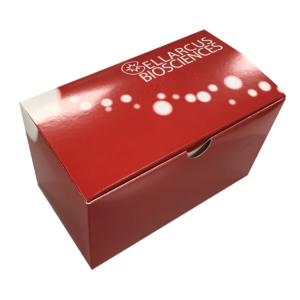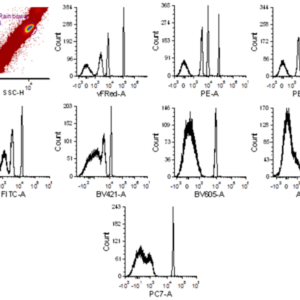vTAG™ ANNEXIN V
NO WASH, QUANTITATIVE PHOSPHATIDYLSERINE MEASUREMENT BY vFC™
$95.00 – $275.00
|
Conjugate(s): PE
Est. Limit of Detection: 30 Molecules per EV
Cargo analysis using vTag™ products should be accompanied by a vesicle specific analysis method such as vFC™. vTag™ products bundled with the vFC™ assay will be discounted 25%. |
Certificate of Analysis
|
||
 TDS TDS |
 MSDS MSDS |
||
Description
Phosphatidylserine labeling (Annexin v) in vFC™
Phosphatidylserine labeling with conjugated Annexin V can be performed using protocol 2 within the vFC™ (#CBS4), handbook. vFC™ enables specific detection and characterization of individual extracellular vesicles such as exosomes and microvesicles on commercially available flow cytometers. Because vFC™ is vesicle specific, we can characterize vesicles and cargo in a highly-reproducible, no-wash assay without artifacts from debris or reagent aggregates. A brief overview of the protocol is provided below. For a full protocol, including instrument setup, calibration, and determination of optimal dilution of EVs, See protocol 2 in the vFC™ kit handbook.
Procedure
- Dilute sample containing EVs to approximately 5×106 extracellular vesicles per µl. To determine vesicle concentration for an unknown sample, see supporting protocols included in the vFC™ kit.
- Prepare a sufficient amount of vFRed™ for all samples and controls (5 µl per well) according to kit instructions
- In duplicate, in the included 96 well plate, add 35 µl of dilution buffer, 5µl of prepared vFRed™, 5 µl of vTag™ Annexin V, and 5 µl of EV samples.
- Incubate in the dark at room temperature for 1 hr.
- Perform serial dilution of the samples as described in the assay handbook. Briefly, samples are to be diluted from between 1:100 to 1:1000 from staining concentration depending upon the flow cytometer being used.
- Run the stained, diluted sample of labeled EVs on a qualified flow cytometer.
Annexin V is used for the detection of phosphatidylserine. Classically, phosphatidylserine is measured as an early marker of apoptosis. PS exposure is an early event in the apoptosis cascade. Within the context of extracellular vesicles research, Annexin V staining of phosphatidylserine is frequently reported and has been quantified by vFC™ on EVs from a number of cell types and biofluids.
-

vFC™ VESICLE FLOW CYTOMETRY EV ANALYSIS ASSAY
FOR COUNTING AND SIZING VESICLES IN BIOFLUIDS, MEDIA, OR BUFFER0 out of 5$450.00 – $2,100.00 Select options This product has multiple variants. The options may be chosen on the product page -

vCAL™ NANORAINBOW BEADS
0 out of 5$225.00 Select options This product has multiple variants. The options may be chosen on the product page
Additional information
| Size | 20 Tests, 100 Tests |
|---|
NO WASH, QUANTITATIVE PHOSPHATIDYLSERINE MEASUREMENT BY vFC™” Cancel reply



Reviews
There are no reviews yet.